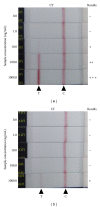Development of an immunochromatographic test strip for detection of cholera toxin
- PMID: 24308002
- PMCID: PMC3838819
- DOI: 10.1155/2013/679038
Development of an immunochromatographic test strip for detection of cholera toxin
Abstract
Because cholera toxin (CT) is responsible for most of the symptoms induced by Vibrio cholerae infection, detection of CT is critical for diagnosis of the disease. In this study, we constructed an immunochromatographic test strip for detection of CT (CT-IC) with polyclonal antibodies developed against purified recombinant whole CT protein. The detection limit of the CT-IC was 10 ng/mL of purified recombinant CT, and it could detect the CT in culture supernatant of all 15 toxigenic V. cholerae isolates examined, whereas no false-positive signal was detected in all 5 nontoxigenic V. cholerae isolates examined. The specificity of the CT-IC was examined with recombinant heat-labile toxin (LT), which shares high homology with CT, and it was revealed that the minimum detection limit for LT was 100 times higher than that for CT. In addition, lt gene-positive enterotoxigenic Escherichia coli (ETEC) was examined by CT-IC. The false-positive signals were observed in 3 out of 12 ETEC isolates, but these signals were considerably faint. The CT-IC did not develop false-positive signals with all 7 V. parahaemolyticus isolates. These results showed the high specificity of CT-IC and the feasible use of it for the detection and surveillance of toxigenic V. cholerae.
Figures



Similar articles
-
Immunochromatographic detection of the heat-labile enterotoxin of enterotoxigenic Escherichia coli with cross-detection of cholera toxin.J Microbiol Methods. 2017 Jan;132:148-152. doi: 10.1016/j.mimet.2016.12.007. Epub 2016 Dec 8. J Microbiol Methods. 2017. PMID: 27940044
-
Detection of Cholera Toxin by an Immunochromatographic Test Strip.Methods Mol Biol. 2017;1600:1-7. doi: 10.1007/978-1-4939-6958-6_1. Methods Mol Biol. 2017. PMID: 28478552
-
Construction and preclinical evaluation of recombinant Peru-15 expressing high levels of the cholera toxin B subunit as a vaccine against enterotoxigenic Escherichia coli.Vaccine. 2007 Dec 12;25(51):8574-84. doi: 10.1016/j.vaccine.2007.09.074. Epub 2007 Oct 26. Vaccine. 2007. PMID: 18045752
-
From cholera to enterotoxigenic Escherichia coli (ETEC) vaccine development.Indian J Med Res. 2011 Feb;133(2):188-96. Indian J Med Res. 2011. PMID: 21415493 Free PMC article. Review.
-
Vaccines for viral and bacterial pathogens causing acute gastroenteritis: Part II: Vaccines for Shigella, Salmonella, enterotoxigenic E. coli (ETEC) enterohemorragic E. coli (EHEC) and Campylobacter jejuni.Hum Vaccin Immunother. 2015;11(3):601-19. doi: 10.1080/21645515.2015.1011578. Hum Vaccin Immunother. 2015. PMID: 25715096 Free PMC article. Review.
Cited by
-
Utilization of Small RNA Genes to Distinguish Vibrio cholerae Biotypes via Multiplex Polymerase Chain Reaction.Am J Trop Med Hyg. 2019 Jun;100(6):1328-1334. doi: 10.4269/ajtmh.18-0525. Am J Trop Med Hyg. 2019. PMID: 30963989 Free PMC article.
-
Aptamer-nanobody based ELASA for detection of Vibrio cholerae O1.Iran J Microbiol. 2020 Aug;12(4):263-272. doi: 10.18502/ijm.v12i4.3928. Iran J Microbiol. 2020. PMID: 32994896 Free PMC article.
-
Quantitative Detection of Shiga Toxins Directly from Stool Specimens of Patients Associated with an Outbreak of Enterohemorrhagic Escherichia coli in Japan--Quantitative Shiga toxin detection from stool during EHEC outbreak.Toxins (Basel). 2015 Oct 27;7(10):4381-9. doi: 10.3390/toxins7104381. Toxins (Basel). 2015. PMID: 26516915 Free PMC article.
-
Development of IgY-Based Sandwich ELISA as a Robust Tool for Rapid Detection and Discrimination of Toxigenic Vibrio cholerae.Can J Infect Dis Med Microbiol. 2018 Oct 2;2018:4032531. doi: 10.1155/2018/4032531. eCollection 2018. Can J Infect Dis Med Microbiol. 2018. PMID: 30386445 Free PMC article.
-
Non-serogroup O1/O139 agglutinable Vibrio cholerae: a phylogenetically and genealogically neglected yet emerging potential pathogen of clinical relevance.Arch Microbiol. 2022 May 14;204(6):323. doi: 10.1007/s00203-022-02866-1. Arch Microbiol. 2022. PMID: 35567650 Free PMC article. Review.
References
-
- Cholera, 2011. The Weekly Epidemiological Record. 2012;87(31-32):289–304. - PubMed
-
- Laboratory Methods For the Diagnosis of Vibrio Cholerae. chapter 7. Centers for Disease Control and Prevention; 1999.
-
- Palchetti I, Mascini M. Electroanalytical biosensors and their potential for food pathogen and toxin detection. Analytical and Bioanalytical Chemistry. 2008;391(2):455–471. - PubMed
Publication types
MeSH terms
Substances
LinkOut - more resources
Full Text Sources
Other Literature Sources

